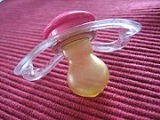
Pacifier
Encyclopedia
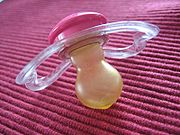
Rubber
Natural rubber, also called India rubber or caoutchouc, is an elastomer that was originally derived from latex, a milky colloid produced by some plants. The plants would be ‘tapped’, that is, an incision made into the bark of the tree and the sticky, milk colored latex sap collected and refined...
, plastic
Plastic
A plastic material is any of a wide range of synthetic or semi-synthetic organic solids used in the manufacture of industrial products. Plastics are typically polymers of high molecular mass, and may contain other substances to improve performance and/or reduce production costs...
, or silicone
Silicone
Silicones are inert, synthetic compounds with a variety of forms and uses. Typically heat-resistant and rubber-like, they are used in sealants, adhesives, lubricants, medical applications , cookware, and insulation....
nipple
Nipple
In its most general form, a nipple is a structure from which a fluid emanates. More specifically, it is the projection on the breasts or udder of a mammal by which breast milk is delivered to a mother's young. In this sense, it is often called a teat, especially when referring to non-humans, and...
given to an infant
Infant
A newborn or baby is the very young offspring of a human or other mammal. A newborn is an infant who is within hours, days, or up to a few weeks from birth. In medical contexts, newborn or neonate refers to an infant in the first 28 days after birth...
or other young child to suck upon. In its standard appearance it has a teat, mouth shield, and handle. The mouth shield and/or the handle is large enough to avoid the danger of the child choking on it or swallowing
Swallowing
Swallowing, known scientifically as deglutition, is the process in the human or animal body that makes something pass from the mouth, to the pharynx, and into the esophagus, while shutting the epiglottis. If this fails and the object goes through the trachea, then choking or pulmonary aspiration...
it.
History
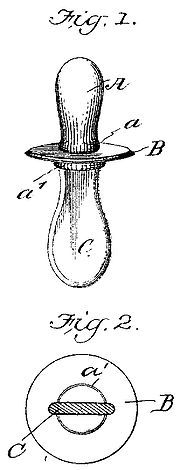
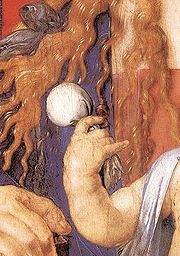
Sugar tit
Sugar tit is a folk name for a baby pacifier, or dummy, that was once commonly made and used in North America and Britain. It was made by placing a spoonful of sugar, or honey, in a small patch of clean cloth, then gathering the cloth around the sugar and twisting it to form a bulb...
s, sugar-teats or sugar-rags which had been in use in 19th century America. A writer in 1873 described a "sugar-teat" made from "a small piece of old linen" with a "spoonful of rather sandy sugar in the centre of it", "gathered ... up into a little ball" with a thread tied tightly around it. Rags with foodstuffs tied inside were also given to babies in many parts of Northern Europe and elsewhere. In some places a lump of meat or fat was tied in cloth, and sometimes the rag was moistened with brandy. German-speaking areas might use Lutschbeutel: cloth wrapped round sweetened bread, or maybe poppy-seeds. A Madonna
Madonna (art)
Images of the Madonna and the Madonna and Child or Virgin and Child are pictorial or sculptured representations of Mary, Mother of Jesus, either alone, or more frequently, with the infant Jesus. These images are central icons of Roman Catholicism and Eastern Orthodox Christianity where Mary remains...
and child painted by Dürer in 1506 shows one of these tied-cloth "pacifiers" in the baby's hand.
Pacifiers were settling into their modern form around 1900 when the first teat, shield and handle design was patented in the US as a "baby comforter". Rubber had been used in flexible teethers sold as "elastic gum rings" for British babies in the mid-19th century, and also used for feeding-bottle teats. In 1902 Sears Roebuck advertised a "new style rubber teething ring, with one hard and one soft nipple", and in 1909 someone calling herself "Auntie Pacifier" wrote to the New York Times to warn of the "menace to health" (she meant dental health) of "the persistent, and, among poorer classes, the universal sucking of a rubber nipple sold as a 'pacifier'." In England too, dummies were seen as something the "poorer classes" would use, and associated with poor hygiene. In 1914 a London
London
London is the capital city of :England and the :United Kingdom, the largest metropolitan area in the United Kingdom, and the largest urban zone in the European Union by most measures. Located on the River Thames, London has been a major settlement for two millennia, its history going back to its...
doctor complained about "the dummy teat": "If it falls on the floor it is rubbed momentarily on the mother's blouse or apron, lipped by the mother and replaced in the baby's mouth."
Early pacifiers were manufactured with a choice of black, maroon or white rubber, though the white rubber of the day contained a certain amount of lead. Binky (with a y) was first used as a brand name for pacifiers and other baby products in about 1935 and is currently owned by Playtex Products, Inc. as a trademark in the U.S. (and a number of other countries).
Drawbacks
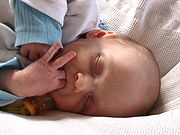
Breastfeeding
Breastfeeding is the feeding of an infant or young child with breast milk directly from female human breasts rather than from a baby bottle or other container. Babies have a sucking reflex that enables them to suck and swallow milk. It is recommended that mothers breastfeed for six months or...
, especially if introduced within the first 6 weeks of life.
Children who suck pacifiers may be more prone to ear infections (otitis media
Otitis media
Otitis media is inflammation of the middle ear, or a middle ear infection.It occurs in the area between the tympanic membrane and the inner ear, including a duct known as the eustachian tube. It is one of the two categories of ear inflammation that can underlie what is commonly called an earache,...
).
Some older infants may have delayed speech development due to the pacifier's constant presence in their mouths preventing them from practising their speaking skills.
Prolonged use past the first few years can cause dental problems.
Benefits
Researchers have found that use of a pacifier is associated with a substantial reduction in the risk of SIDSSudden infant death syndrome
Sudden infant death syndrome is marked by the sudden death of an infant that is unexpected by medical history, and remains unexplained after a thorough forensic autopsy and a detailed death scene investigation. An infant is at the highest risk for SIDS during sleep, which is why it is sometimes...
(Sudden infant death syndrome). A meta-analytic study published by American Pediatric Association in Pediatrics in October 2005 supports this benefit to 1 year of age. However, other experts, while acknowledging the correlation
Correlation
In statistics, dependence refers to any statistical relationship between two random variables or two sets of data. Correlation refers to any of a broad class of statistical relationships involving dependence....
between SIDS risk reduction and the pacifier use, questioned the causality
Causality
Causality is the relationship between an event and a second event , where the second event is understood as a consequence of the first....
of the findings. Additionally, some parents prefer the use of pacifiers to the child sucking their thumbs
Thumb sucking
Thumb sucking is a behavior found in humans, chimpanzees, captive Ring-tailed Lemurs, and other primates. It usually involves placing the thumb into the mouth and rhythmically repeating sucking contact for a prolonged duration...
. Researchers in Brazil have shown that neither "orthodontic" nor standard pacifiers prevent dental problems if children continue sucking past the age of three years.
Medical policies
The American Academy of Pediatric Dentistry's "Policy on Thumb, Finger and Pacifier Habits" says: "For most children there is no reason to worry about a sucking habit until the permanent front teeth are ready to come in."A study of sudden infant death syndrome (SIDS) published in Pediatrics, the journal of the American Academy of Pediatrics (AAP) states that "It seems appropriate to stop discouraging the use of pacifiers." The authors recommend the use of pacifiers at nap time and bedtime throughout the first year of life. For breastfeeding mothers, the authors suggest waiting until breastfeeding is well established, typically for several weeks, before introducing the pacifier.
The British Dental Health Foundation's FAQ page recommends: "If you can, avoid using a dummy and discourage thumb sucking. These can both eventually cause problems with how the teeth grow and develop. And this may need treatment with a brace when the child gets older."
Adult pacifiers
Adult-sized pacifiers, consisting of a standard baby pacifier guard but a larger, wider nipple, are used by some members of the Adult Baby community. The nipples are often referred to as NUK5s, after the NUK brand of baby pacifiers manufactured by the German company MAPA GmbH. They are sold under the name NUK Medicpro L or NUK Size 5.Recent studies have also shown that pacifier use among adults may cut down or completely eliminate snoring.
Prevalence of attachments to pacifiers and their psychological functions
It wasn’t until the late 1970s that researchers were able to dispel the notion that pacifiers were psychologically unhealthy and aberrant. Richard H. Passman and Jane S. Halonen at the University of Wisconsin-Milwaukee traced the developmental course of attachments to pacifiers and provided norms. They found that 66% of their sample of three-month olds in the United States demonstrated at least some attachment, according to their mothers. At six months of age, this incidence was 40% and at nine months, 44%. Thereafter, the rate of attachment to pacifiers dropped precipitously until, at 24 months of age and later, it was quite rare.These researchers also provided experimental support for what were then only anecdotal observations that pacifiers do indeed pacify babies. In an unfamiliar playroom, one-year-old infants accompanied by their pacifier evidenced more play and demonstrated less distress than did babies without them. The investigators concluded that pacifiers should be considered to be attachment objects, similar to other security objects like blankets.
Passman and Halonen contended that the widespread occurrence of attachments to pacifiers as well as their importance as security objects should reassure parents that they are a normal part of development for a majority of infants.
See also
- The Glot-UpGlot-UpA Glot-Up is type of dental equipment, something in between a mouth guard and an adult-sized pacifier.It was designed by an Acupuncture and Osteopathy Practice in Barcelona...
, a combination mouth guard and adult-sized pacifier - Pacifier-activated lullabyPacifier-activated lullabyPAL: Pacifier Activated Lullaby is a pacifier fitted with an adaptor housing a computer chip that activates a CD player outside the incubator. Developed in 2000 by Dr. Jayne M...
- Security blanket

